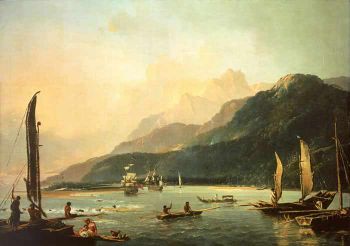In the summer of 1772, a curt letter from the Admiralty informed Captain James Cook that an artist had been hired to act as official draughtsman on the explorer’s second Pacific voyage. “We have engaged Mr William Hodges, a Landskip Painter, to proceed in his Majesty’s Sloop under your Command on her present intended Voyage in order to make Drawings and Paintings as may be proper to give a more perfect idea thereof than can be formed from written descriptions only…” Together with the astronomer, William Wales, and the father-and-son team of naturalists, Johann and George Reinhold Forster, Hodges accompanied Cook and his crew into the previously uncharted waters of the far Pacific. He travelled around the Cape of Good Hope; he encountered furious storms and awe-inspiring waterspouts, whirled into the sky by oceanic tornadoes; he saw the icebergs of Antarctica; and he travelled to the startlingly unfamiliar landscapes of Tahiti and the Society Islands. He painted landscapes and seascapes. He painted portraits of the South Sea Islanders and depicted several of the first encounters between them and Cook’s men. On his return, in 1775, he won a two-year extension of his contract, which he used to create a series of large-scale paintings intended to moralise his plethora of experiences of a hitherto unknown world into some kind of overarching significance.
The result of Hodges’ labour was an extraordinary body of work which has long languished in obscurity. He is thinly represented in the Tate Gallery and not at all in the National Gallery. His name is infrequently encountered, even in textbooks on eighteenth-century British painting. This is largely the consequence of his exclusive contract with the Admiralty, which took possession of virtually all of his paintings of the Pacific – the principal masterpieces of his relatively brief career –...

William Hodges, 1744-97: The Art of Exploration, at the National Maritime Museum
11-07-2004

